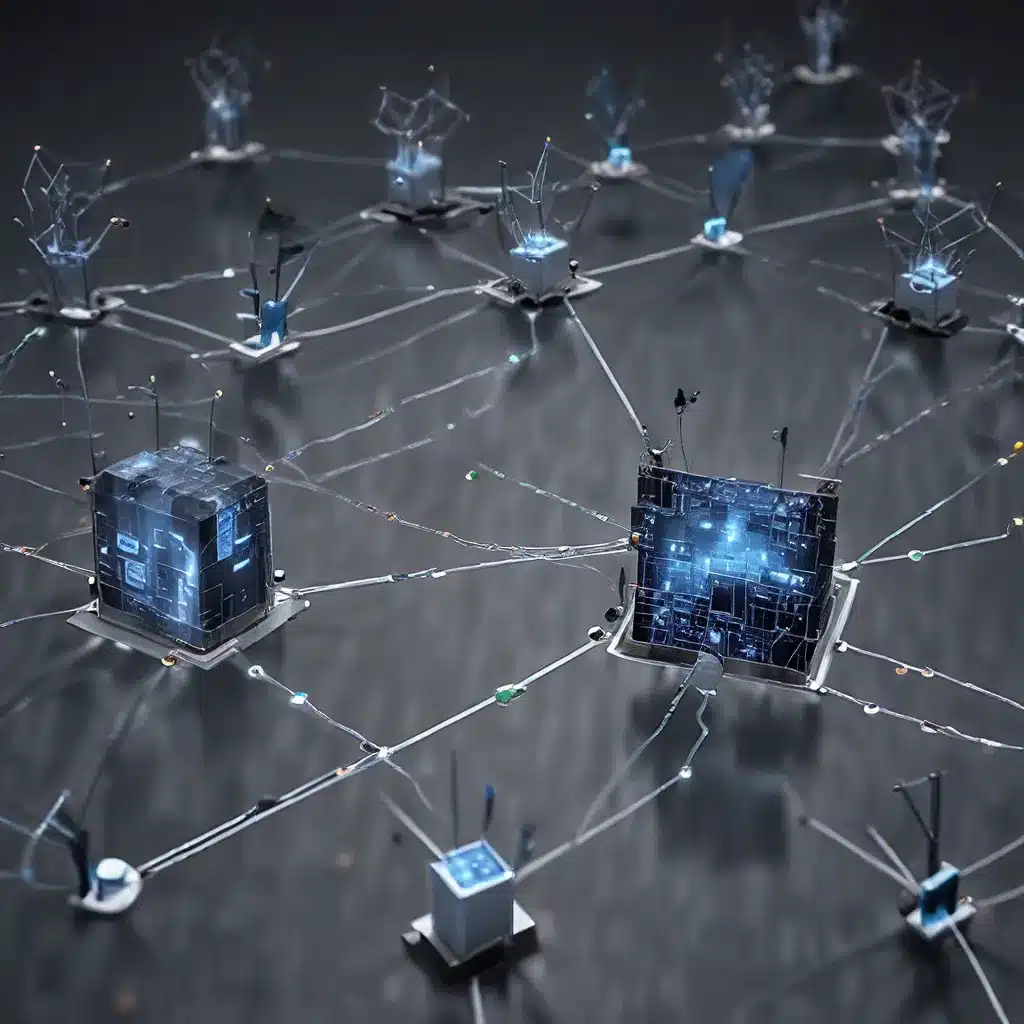
As the Internet of Things (IoT) continues to revolutionize the way we interact with the world around us, the role of sensor networks has become increasingly crucial. These networks, comprising interconnected multi-sensor IoT devices, have the ability to gather diverse data types and provide targeted responses to a wide range of applications. However, the growing complexity of IoT applications also presents unique challenges, particularly in the areas of energy management and secure data processing.
Powering the IoT: Energy-Harvesting Sensor Networks
One of the primary concerns in sensor network design is the efficient use of energy resources. Traditional battery-powered sensor nodes often have limited operational lifetimes, which can be problematic for applications that require continuous monitoring or long-term deployment. This is where energy-harvesting sensor networks come into play, leveraging renewable energy sources to extend the lifespan of these critical infrastructure components.
Harnessing Ambient Energy
Energy-harvesting technology enables sensor nodes to scavenge energy from their surrounding environment, such as solar, thermal, or vibration sources. By incorporating these energy-harvesting capabilities, sensor networks can operate autonomously, reducing the need for frequent battery replacements or recharging. This not only enhances the sustainability of the network but also minimizes the maintenance overhead, making it a more cost-effective and efficient solution for IoT applications.
Distributed Energy Management Algorithms
To effectively manage the energy resources in these energy-harvesting sensor networks, researchers have developed distributed algorithms that optimize the energy usage and distribution across the network. These algorithms leverage the decentralized nature of sensor networks, allowing individual nodes to make autonomous decisions based on local information and resource availability.
One such algorithm is the Earliest Deadline First (EDF) scheduling approach, which prioritizes tasks based on their deadlines, ensuring that critical data is processed in a timely manner. This is particularly relevant in IoT applications that require real-time responses and low latency, such as in industrial automation or smart city monitoring.
Adaptive Energy Allocation
Another key aspect of energy management in sensor networks is the ability to adaptively allocate resources based on changing environmental conditions or application requirements. Distributed algorithms can dynamically adjust the sensing activities or processing tasks performed by each node, striking a balance between energy consumption and the desired level of service.
This adaptive approach allows sensor networks to optimize their energy usage and prolong their operational lifespan, ultimately contributing to the sustainability and reliability of IoT systems.
Securing the IoT: Challenges and Solutions
As sensor networks become increasingly integral to IoT ecosystems, the security of these systems has become a critical concern. The distributed nature of sensor networks, coupled with the limited resources of individual nodes, presents unique challenges in protecting against cyber threats.
Addressing IoT Security Vulnerabilities
IoT devices, including sensor nodes, are often susceptible to various security vulnerabilities, such as unauthorized access, data tampering, and denial-of-service attacks. These vulnerabilities can compromise the integrity of the data collected by the sensor network, as well as the overall reliability and resilience of the IoT system.
To mitigate these risks, researchers have explored secure communication protocols and lightweight cryptographic algorithms that can be implemented within the constraints of sensor nodes. By ensuring the confidentiality, integrity, and availability of data, these security measures help safeguard IoT applications from malicious actors.
Fog Computing for Secure Data Processing
In addition to securing the sensor nodes themselves, the data processing and decision-making within IoT systems must also be protected. Fog computing has emerged as a viable platform for processing IoT data, providing a distributed computing infrastructure closer to the data sources.
By leveraging fog nodes to perform secure data aggregation and edge analytics, IoT systems can reduce the risk of data breaches and ensure the privacy of sensitive information. This distributed approach to data processing also enhances the responsiveness of the system, as critical decisions can be made closer to the end-users or devices.
Balancing Security and Efficiency
As with any technology, the implementation of security measures in sensor networks must be carefully balanced with energy efficiency and computational constraints. Designers of IoT systems must find the right trade-offs between robust security, low latency, and optimal resource utilization to create a secure yet efficient ecosystem.
The Future of Sensor Networks in IoT
The advancements in sensor network technology and the growing popularity of IoT have opened up a wide range of applications that leverage these interconnected systems. From smart cities and industrial automation to environmental monitoring and healthcare, sensor networks are playing a crucial role in data collection, processing, and decision-making.
Emerging IoT Applications
One area where sensor networks are making a significant impact is in smart city initiatives, where multi-sensor IoT devices are deployed to monitor and manage various infrastructure components, such as traffic flow, air quality, and energy consumption. By aggregating and analyzing the data collected by these sensor networks, city authorities can make informed decisions, optimize resource allocation, and improve the overall quality of life for citizens.
In the industrial domain, sensor networks are enabling predictive maintenance and process optimization in manufacturing, helping to reduce downtime, improve efficiency, and enhance product quality. Additionally, sensor networks are being utilized in environmental monitoring applications, such as wildlife tracking, pollution detection, and natural disaster response, providing valuable data for researchers and policymakers.
The Role of Distributed Algorithms
As the complexity of IoT applications continues to grow, distributed algorithms will play an increasingly important role in managing the energy, security, and resource allocation within sensor networks. These algorithms will need to adapt to the dynamic nature of IoT environments, ensuring that sensor networks can operate reliably, securely, and efficiently, even in the face of changing conditions or emerging threats.
By harnessing the power of energy-harvesting and distributed computing, sensor networks will become more sustainable and resilient, paving the way for the next generation of smart, connected systems that will transform our world.
To learn more about the latest advancements in sensor networks and IoT, visit the sensor-networks.org website, where you’ll find a wealth of information, insights, and resources from industry experts and thought leaders.